
EVERYONE'S A WINNER AT THE KENTUCKY DERBY MUSEUM
The people who helped create the new Kentucky Derby Museum in Louisville are the first to tell you they didn't know a fetlock from a furlong when they undertook the project. "The fatal mistake most sports museums make is to hire an insider to decide what's important," says executive director Randy W. Ray, who came to the museum after serving as curator of collections for the Museum of Science and Industry in Tampa. "We wanted to make this museum 'user friendly,' a place that would appeal to the racing novice as well as the racing expert."
Dedicated in 1985, the new museum was made possible by a $7.5 million grant from the foundation of the late J. Graham Brown, a Louisville industrialist, and is conveniently located on the grounds of Churchill Downs, adjacent to the Kentucky Derby track. Like a racetrack, the museum is in the shape of an oval. Unlike a U.S. race, however, the exhibits proceed in a clockwise direction. Some might consider museum a stuffy word, but don't be put off by it; this one's a winner. I ought to know, I visited the museum in its previous incarnation.
In 1972 I made my first trip to the Kentucky Derby and paid the museum a visit. Back then the displays consisted mostly of a bunch of moldy-looking silks hanging along badly lit walls, with the owners' names on little plaques under each set. Were Aristides' boots on display back then? Probably, but I can't remember. That was a "museum," dryasdust and quite forgettable. If the boots were on display, there was undoubtedly a sign that read, BOOTS WORN BY ARISTIDES, FIRST KENTUCKY DERBY WINNER. I would have read the sign, learned who the first Derby winner was and left, wondering why anyone would put boots on a horse.
Happily, the new museum is a different place altogether. I have visited every year since it opened, always on the Thursday before Derby Saturday. That's when they draw the post positions for the race there, and the Great Hall of the museum is so crammed with owners, trainers, press and TV camera crews that there's scarcely room to breathe. And every year I've stayed long after the posts were drawn, especially to watch the multi-image slide show, which is updated each year, and to take a quick look at this or that exhibit. Quick looks are about as good as it gets during Derby week. The place is so crowded it's hard to linger.
I paid another visit to Churchill Downs last June and discovered that the best time to go to the Derby museum, which is open every day except Christmas, Thanksgiving, Oaks Day (the day before the Derby) and Derby Day, is anytime except the week of the big race.
So on that summer morning, as I stood on the main floor (there are three levels) staring at Aristides' boots, the first call came over the P.A. system. "Ladies and Gentlemen," the recorded voice announced, "five minutes to post time in the Great Hall." Good, I thought, I had time to contemplate the boots and the sign underneath that reads: ARISTIDES' BOOTS-WORN BY HIM IN 1875. THEY ARE ACTUALLY PROTECTIVE SPATS WHICH WERE STRAPPED AROUND THE HORSE'S ANKLES.
Why was I lingering in front of these two ancient pieces of canvas with leather straps and buckles attached to them? Well, for one thing, Aristides is my paternal grandfather's and my eldest brother's name, so right away that makes Aristides my favorite Derby winner. For another, I wondered where these boots had come from. Had the family of Aristides' owner, H. Price McGrath, carefully preserved the boots, passing them down from generation to generation? Could the McGraths have foreseen that the Kentucky Derby would continue uninterrupted for 115 years and counting? That it would come to be known throughout the world as "The greatest two minutes in sports"? And its trophy the most coveted in all of racing? Actually, I don't want to know. I prefer to think that the family loved Aristides so much, they saved his boots to remember him by.
"Two minutes to post time in the Great Hall," the P.A. system announced.
By this time there were about three dozen people in the museum. I moved a step or two from the Aristides display and read: 1875-37 STATES IN THE U.S. BOSTON FIRST BASEMAN CHARLES WAITE USES FIRST BASEBALL GLOVE. FIRST KENTUCKY DERBY. McGrath had two horses entered in that first Derby, Chesapeake, his big bay, and Aristides, the "little red horse" who would be Chesapeake's rabbit. Sure enough, Aristides, with jockey Oliver Lewis up, set a fast pace and was still in the lead as the horses reached the turn for home. At this point, according to the plan, Aristides would be finished and Chesapeake would zoom to the lead and victory. But Chesapeake never made his move. Fortunately, McGrath was standing at the head of the stretch to give directions. "Go on!" he yelled to Lewis, waving his hat toward the finish line. Lewis and Aristides did go on, winning the 1½-mile race in 2:37¾, an American record for a 3-year-old. (The race was shortened to 1¼ miles in 1896.)
I long to be transported to McGrath's side on that day in 1875, as the horses thunder by and he waves his hat wildly and screams for Lewis to "Go on! Go on!" There is a time machine in the museum, but it doesn't go back to that first race. You can, however, watch films and TV broadcasts of the past 66 Derbies on a five-by-five-foot screen. Step up to a console, press a button for the year you want and—presto!—there's Reigh Count, in grainy black and white and no sound, winning in 1928, or Spend A Buck, in color, with the track announcer calling the race as the colt leads all the way in 1985.
"One minute to post time in the Great Hall. Please join us for the greatest race."
The lights dim in the Great Hall; a hush falls over the crowd. Ten feet above the floor, 96 slide projectors hurl images around the 360-degree oval screen. It's the Churchill Downs backstretch, 5:30 a.m. Birds chirp, a horse whinnies, and "You are there," as Walter Cronkite used to say. In just under 14 minutes, the visitor is taken through Derby Day, starting at dawn when all is quiet, to the race itself, with the horses thundering toward the wire and the crowd roaring.
The focus of the show, which was created by Donna Lawrence Productions of Louisville, is the 1984 Kentucky Derby and its winner, Swale. Along the way, a mare is shown lying down to give birth to a foal that may someday win the Derby, and the voices of Swale's trainer, Woody Stephens, his jockey, Laffit Pincay Jr., and of John Sosby, the manager of Claiborne Farm (where Swale was foaled), are heard talking about their hopes for this colt. There are pictures of horses working out in the morning fog, and you hear the sound of hoofbeats as they gallop along the screen. Then the sights and sounds of Derby Day surround the visitor, accompanied by music with a driving beat that quickens in tempo as the "day" progresses. Here are phones ringing off the hook in the track offices, harrows working the track, planes by the hundreds landing at Standiford Field, the parties, the vendors, the beautiful women in their elaborate hats and then, suddenly, all around the room, Churchill Downs is projected in its entirety so that you feel as if you're standing smack in the middle of the infield surrounded by the roar of hundreds of thousands of fans. This is a showstopper. Visitors' mouths drop open and their eyes light up as they turn and turn again to take it all in. My reaction is the same every time. I get teary-eyed and break out in goosebumps.
Then you hear Pincay: "I said, 'God, I never asked you to help me win a race, but if you could give me a little push, I'd appreciate it.' " And then, after Swale wins, Sosby, his voice choked with emotion: "I wanted to run. I wanted to fly. I was crying. I wanted to tell the world who he was and what we'd done with him; that he was our horse...." These words are especially poignant because only six weeks later, a week after winning the Belmont Stakes, Swale died.
Each year, the end of the slide show is updated so that the visitor can hear the track announcer's call and see the most recent Kentucky Derby winner's stretch run. The multi-image show is repeated hourly, starting at 9:30 a.m., continuing until 4:30 p.m. The lower level of the museum has a changing exhibit of art works, and the upper level is designed so that you move from exhibit to exhibit, with numbers on pillars to guide the way. It starts with the ancient Greeks, who believed the horse was given to man as a gift from Poseidon, god of the sea, and moves on to tell you everything you ever wanted to know about conformation, the mechanics of a horse's stride, breeding, etc. For those who don't want to learn about the technical aspects of horses and horse racing, there are other fun things to see and do. A full-sized plaster horse stands in a real starting gate next to a big mirror painted with the outline of a jockey in a riding crouch. Visitors can climb on the plaster horse and compare their riding seat with the jockey's.
All in all, there's something for everybody, from preschoolers to jaded race-goers. The museum is open from 9 a.m. to 5 p.m. Admission is $3.00 for adults, $2.50 for seniors 65 and over and $1.50 for children 5 to 12. It's the next-best thing to being at trackside on the first Saturday in May. And after you visit, you can tell people you went to see the Kentucky Derby at Churchill Downs, and you won't even be lying.
PHOTO
BILL LUSTER
A slide show on the Great Hall's oval screen recreates the sights and sounds of Derby Day.

